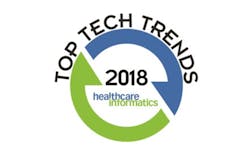Last fall, the Boston-based Partners HealthCare system launched a project with the aim to provide its clinicians and researchers with access to patient-generated health data (PGHD) from more than 420 consumer and clinical health devices. Working with Durham, N.C.-based vendor Validic, Partners Connected Health announced its plan to integrate PGHD into care plans and the electronic health record (EHR) throughout the Partners HealthCare network this year.
Of course, Partners HealthCare is far from the only organization working on PGHD projects across the U.S., but the initiative, along with many others, proves that patient care systems are turning more toward collecting and integrating key data from consumers that is accumulated outside of a facility’s four walls. Indeed, during the second quarter of 2018, wearables were one of the top-funded categories for digital health VC funding, according to a Mercom Capital Group report.
That said, plenty of fundamental challenges remain, even as the motivation to integrate PGHD into clinical processes increases. For one, patients must be willing to use the devices and be engaged in collecting their own data. In the Partners HealthCare/Validic project, the devices used were either ones that patients already owned and were comfortable with, or were purchased from Amazon or someplace similar. In previous PGHD initiatives, Partners HealthCare tried to get most patients to use a single device, but the results were less than ideal, recalls Kelly Santomas, R.N., senior director, Partners Connected Health, an arm of Partners HealthCare.
For this initiative, Santomas’ team particularly wanted to collect data on patients’ blood pressure and glucose levels, activity and weight. She notes that the data is being integrated into providers’ EHRs, and that incorporation has not been difficult. The challenge with this project, so far, she says, has been fighting the perception that the patient data is not valid.
For instance, Santomas offers, if a patient is taking his or her blood pressure at home, and then that recordation is sent to the EHR, some providers might see that number as invalid. “But that’s a misconception,” she asserts. “It’s interesting, because we send patients home right now, tell them to buy a blood pressure cuff, write down their levels, and email it to us. So how do we know that is valid? You are assuming patients will do the right thing and give the right information, and working within [providers’] perceptions [on that] is the biggest challenge,” she contends.
Kelly Santomas, R.N.
Brian Modena, a clinical researcher at the Scripps Translational Science Institute who has researched the effectiveness of mobile health data gathered outside the doctor’s office, also believes that integrating this information into EHRs “is easily doable.” But Modena doesn’t see this being done industry-wide and he says that’s because “healthcare is always so slow to adapt, and people are used to the old way.” The “old way,” he says, involves a nurse taking a patient’s blood pressure and handing that off to the doctor, who then gives the patient advice. “The question becomes, are doctors going to look at PGHD? And if so, how often will they use it? What type of format should you put it into so doctors can easily process it?”
To this end, Santomas believes that physicians genuinely do want to incorporate patient-generated data, but it needs to be presented in a way that makes sense and is actionable to them. “They don’t have the time to sift through [non-valuable] information. So we need to make sure we are providing the data in a format that makes sense, is actionable, and benefits the patient in the long run,” she says.
UPMC Innovating Toward a Patient-Centered Future
In 2017, the University of Pittsburgh Medical Center (UPMC) said it would be investing in Xealth, a digital health startup that offers a digital prescribing platform, allowing clinicians to prescribe patients digital educational content, disease management apps and monitoring devices.
Rasu Shrestha, M.D., chief innovation officer and executive vice president at UPMC Enterprises—the health system’s innovation hub that funds promising health tech ventures—says that one of the primary reasons for the investment was to solve what he believes is a major barrier in advancing forward with patient-generated health data: an EHR divide that exists between providers and patients.
As Shrestha sees it, on one end, clinicians spend a great deal of time in their EHRs, as that’s where they document and how they bill. “Essentially, it’s how they provide care, and these care pathways and decisions they make are all documented and contained in the EHR,” he says. But at the other end, patients don’t live in the EHR. “At best, they maybe live on their phones, and they might use apps that might be connected to mobile devices. But these apps and devices are separate and are different from the EHR, and they don’t communicate well with each other. So you have these two divides, these two worlds, that are coexisting in these two different spheres,” Shrestha says.
Rasu Shrestha, M.D.
What’s more, if patients do download a health data app, it’s likely they won’t use it very frequently, and even if they do, they might also be fitness fanatics and own Fitbits and Apple Watches, meaning there is a lot of data that is remaining in the confines of the patients, apps, and devices, and in no meaningful way is being made back to the physician’s eyeballs, explains Shrestha. “Patients might make mention of this [data] during an annual visit and maybe they even take printouts. But that’s the extent of the interaction we see today,” he adds.
Bridging that divide was a big factor in the work UPMC is doing with Xealth. Shrestha says that the two organizations are co-creating a set of capabilities that will allow for clinicians who live in their EHRs to directly prescribe apps to their patients, much like how they are prescribing medications in the EHR today.
The prescribed apps then appear on patients’ phones, and with patients’ permission, a bi-directional interface can be created between apps and devices—through the patients’ phones, to the EHR. “Data would then be consumed in a matter that the EHR could understand,” Shrestha says. “All of the readings and the data elements would then be available to the clinical decision support systems within the EHR, or through various means into the database of the EHR itself. That is something that is noble and unique, and this needs to be a standard of care and best practice across the board,” Shrestha asserts.
And UPMC physicians are embracing the validity and quality of the data, too, he adds. Up until as recently as a year ago, he notes, physicians were resistant to engaging patients and consumers. But what were once disconnected experiences and data that simply was overbearing for clinicians in the little amount of time they had has now become data that is easily consumable and digestible for them, Shrestha says. “I am seeing that change happen in front of my very eyes.”
What Could Apple’s Role Be?
In June, Apple introduced a Health Records API (application programming interface) for developers and researchers with the goal “to create an ecosystem of apps that use health record data to better manage medications, nutrition plans, diagnosed diseases and more.”
The Health Records feature allows patients of hundreds of hospitals and clinics to access medical information from various institutions organized into one view on their iPhone. “For the first time, consumers will be able to share medical records from multiple hospitals with their favorite trusted apps, helping them improve their overall health,” Apple officials stated at the time. And starting this fall, Apple officials say that developers building health apps can individualize experiences based on the user’s unique health history.
Shrestha, for one, says he’s excited about the way Apple is approaching things. “It’s a really good thing that there is now one place on patients’ iPhones where they can collect information that belongs to them from any health institution that they have their data in, and that they can also send data back to the hospital. That’s a big deal for patients,” he says.
But, he adds that it shouldn’t be just about the Apple ecosystem and iPhones, because “There is also a whole ecosystem of patients and consumers on Android devices and others.” So, Shrestha asks, “How do we make sure we enable a much broader view to apps that may reside across other ecosystems and allow for that bi-directional interface to happen?”
In the end, Partners Connected Health’s Santomas believes that it’s realistic to think PGHD can soon be used to improve clinical outcomes. “Ideally, I’d love to see a world where the patient can access the healthcare system virtually, on their phones and computers, and as a provider I can sit there and talk to patients, pull up their record, and pull up their PGHD so I can have a sense of what’s going on while they’re at home,” she says. “All of that works together and gives us a much more holistic view of what’s going on with the patient versus just these small episodes of when I see them only in the office. That’s my vision.”




